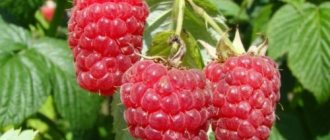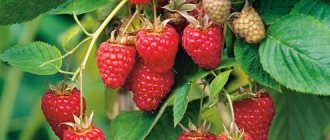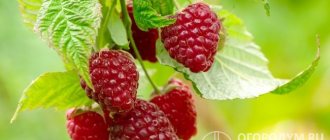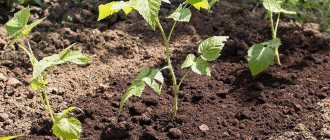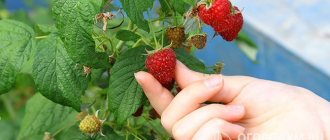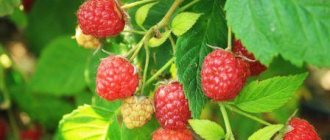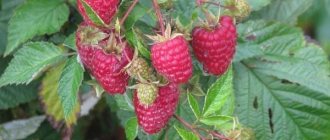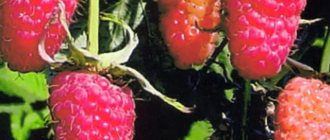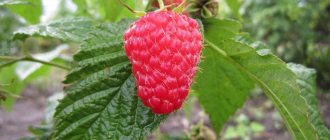Description of varieties of large-fruited raspberries
Many large fruits are superior in taste to ordinary raspberries. And the largest in size are the berries of the first harvest, which grew on more powerful, healthy branches. Another important feature of raspberry varieties with large fruits is the ability of fruit branches to branch: they can form 3 - 5 rows, respectively, and produce much more fruit.
The yield of large-fruited raspberries becomes higher not only due to the branching of lateral branches. With good care, the intensity of fruiting increases several times. Some of these plants are capable of producing at least 5 - 6 kg in one harvest season. The large size of the berries plays a significant role in this.
And yet it is worth remembering that large raspberries do not really like winter. It can withstand frost and thaw very well. When choosing the northernmost winter-hardy variety of large-fruited raspberries for planting, for example, in Siberia, it is still worth paying attention first of all not to the size of the berries, but to their winter hardiness.
Raspberry variety Maravilla
Relatively new varieties of raspberries can be considered using the example of Maravilla, which was recently bred in America. The bush has a height of 2 meters, small thorns. Blooms with large and medium-sized flowers. It is economically beneficial, as it is famous for its good harvest, therefore it is suitable for large-scale, industrial breeding. Loves the large space that the plant needs for sufficient development of the root system.
Maravilla raspberries produce a harvest from July to October, the fruits are harvested 2 times. The berries are large, shiny, and easy to remove. After picking the berries, the top of the bushes is cut off, leaving about 1.5 m for next year.
Raspberry variety Giant Moscow
This name will certainly appear in gardening catalogs where new large-fruited raspberry varieties are presented, because such a huge raspberry simply does not exist! Ripens early, by early July. It has very beautiful conical berries, red in color, very juicy and dense. Their size reaches 25 g. Thanks to their good density, they are easy to transport. The taste is very pleasant, aromatic, the pulp melts in the mouth, the seeds are almost not felt. The berries are great for eating, as well as for jam, jellies and other homemade preparations.
A detailed description of the Moscow Giant raspberry variety characterizes the shoots of the plant as well-developed, compressed, quickly growing up to 2 m. 8-10 replacement shoots and 4-5 shoots of the root system are formed. The variety is very productive; up to 12 kg are harvested from a bush.
Raspberry variety Giant ruby
One of the best remontant large-fruited species, which is valued for its early ripening and productivity. The height of the bush is 1 - 1.6 m. 2-2.5 kg of berries are collected from the bush at a time. The sweet, sour and aromatic taste of the fruit is refreshing at any time: fresh in the summer, in the winter - in the form of jam. If you look at the description of the Ruby Giant raspberry variety and the reviews for it, it becomes clear why many gardeners love it so much.
Productivity, the beauty of shiny conical berries, their good transportation, excellent survival and development in a wide variety of climatic conditions - this is why the Giant ruby raspberry is so popular. It is unpretentious and can grow in almost any natural climate on soil of varying composition.
Raspberry variety Patricia
It has beautiful berries with a very pleasant aroma. They are quite strong: when fully ripe there is no shedding, and when harvested they do not crumble or crush. The bush is large, grows to almost 2 m. From the bush you get 4-5 kg, and if the ground is fertilized with manure, the yield increases by about 2 times. Size of berries: 4 - 14 grams. They have average resistance to frost. In regions where severe frosts can be expected, it is better to bend the shoots to the ground and hide them under the snow. A detailed description of the raspberry variety Patricia confirms the resistance of the species to most diseases. Even if the plant is sick, the yield remains high.
Raspberry variety Yellow giant
Remontant raspberry of a dietary variety. Contains less organic acids than red raspberries, as a result of which it does not irritate the gastrointestinal mucosa. The medicinal description of the Yellow Giant raspberry focuses on the low amount of anthocyanins that the berry contains. Therefore, it can be eaten by allergy sufferers, pregnant women, and small children.
It is also included in the diet of diabetic patients. The berries are large and not very large, up to 8 g. A detailed description of the Yellow Giant raspberry variety contains excellent reviews characterizing this species as very profitable and tasty.
Raspberry variety Morning dew
The variety Porana Rosa, or Morning Dew, was bred in Poland. The berries are large and beautiful. Valued for high yield, excellent quality of fruits and their transportability. Practically not susceptible to diseases. Shoots with hard thorns reach one and a half meters and stretch upward. The upper half of the shoot bears fruit. Short fruit branches can be called a distinctive feature. It is because of them that the bush seems to be literally covered with berries.
Large-fruited raspberry Morning dew is a remontant species. Ripens at the end of June, and also from mid-August until frost. The size of the fruit is 5-7 g, sometimes 10 g. The shape of the berries is round, with good density. The taste is sweet, slightly sour. In extreme heat, raspberries are more sour, but if watered enough, the taste is sweet.
Raspberry variety Zhuravlik
It has an average ripening period, excellent winter hardiness, and excellent immunity to disease. The yield is 2 kg. A small bush produces powerful shoots. The berries are velvety to the touch, weighing 27 - 3.5 g. Reading the description of the Zhuravlik raspberry variety and reviews, you involuntarily notice how tasty and healthy this berry is.
Raspberry variety Orbita
The variety was bred in Leningrad at an experimental fruit and vegetable station. The shoots are medium in size (up to 2 m), erect, which makes them convenient for mechanized processing and harvesting. Fresh annual shoots are red, straight, waxy with thorns. The berries are red, in the form of a wide cone, weighing 3-4 g.
The large-fruited Orbit raspberry has a high yield, loves the sun, loamy, sandy loam soil. The crop's good winter hardiness and disease resistance give this species recognition among gardeners and wide distribution.
Raspberry variety Balsam
At first glance, this is the most ordinary raspberry with the familiar forest taste. But among mid-early varieties it is the best in a number of characteristics. Namely: climate resistance, productivity, frost resistance. Having studied the description of the Balsam raspberry variety, you are imbued with respect for it: for more than 30 years it has been a favorite among gardeners for its excellent taste and unpretentiousness. Productivity 2.2 kg, fruits are set on two-year-old shoots, fruiting begins in late June - early July, ripens very quickly.
The length of the shoots is 170-180 cm, there are few thorns on them, but they are quite tough. Propagated by shoots, after 2 years they grow by 1 square. meter up to 20 pcs. The fruits are a deep crimson color, matte, as if coated. The weight of the berry is 2.5 - 3.4 g. The density is good, thanks to which it feels good during transportation.
Raspberry variety Eurasia
The variety was bred in 1994. The fruits ripen in early August, the harvest does not take long - until mid-September. It has an erect bush, the height of which is slightly higher than one and a half meters, similar to a short tree. In the second year, 5-6 shoots are formed. The spines are located at the base; there are few of them at the top. Annual branches are large, purple in color, with a shiny coating. The shoots of the second year are brown in color, quite strong and do not fall under the weight of the crop.
A detailed description of the Eurasia raspberry variety shows that this species is truly universal, which has numerous positive reviews. The growing technology is simple, the taste of the berries is sweet with a pleasantly refreshing sourness. 2.2 - 2.6 kg are collected from the bush. If you intensively and correctly fertilize the soil under the bush, the yield increases by 2 times.
This variety is recommended for cultivation on soils of different compositions and in different climates.
Slow propagation of shoots can be considered both a positive quality of the plant (raspberries practically do not thicken) and as a disadvantage (you need to wait longer for the growth of new fruit-bearing branches). As for the only fruiting of the year, it is always more abundant than in some species that produce crops twice a year.
Raspberry variety Generalissimo
This is the variety of the largest-fruited raspberry, the real pride of breeders. Its berries reach 4 cm in length, their weight is approximately 11 g. It is for this reason that the plant was given such a loud name. The fruits have a bright red color, excellent density and hardness. Thanks to these qualities, raspberries are convenient to pack and transport. The climate for such a plant to grow must be more or less warm. The fruit ripening time is not very compressed, but the productivity of the Generalissimo constantly surprises: 5 kg per plant.
A detailed description of the Generalissimo raspberry variety is a listing of all its advantages, which are valued by experienced gardeners and beginners. Despite its low resistance to harsh winters, the plant perfectly resists various diseases.
Raspberry variety Izobilnaya Kazakova
This is a remontant raspberry, the bush of which grows up to 2 meters in height. The plant is not very spreading and has powerful stems. Replacement shoots appear in the amount of 8 - 10 pieces. Removing excess shoots prevents the raspberry tree from growing too much; it is recommended to leave no more than 10 fruit-bearing branches on one bush.
The Izobilnaya Kazakova raspberry produces a lot of fruits, the berries are very large, weighing up to 12 g. The taste is rich, the density is excellent, which helps with collection and transportation. In terms of its juiciness, this variety is no worse than the taste of the best types of forest raspberries.
Harvest occurs in mid-August. Large berries tilt the stems downwards, therefore, as the detailed description of the raspberry variety Izobilnaya Kazakova advises, the stems need to be tied up. They require support. As for the popularity of this species, for its excellent taste, excellent productivity, resistance to various diseases and weather conditions, it has earned the highest rating from gardeners.
Raspberry variety Maroseyka
Anyone who likes to grow large-fruited sweet raspberries on their plot will not ignore this description of the Maroseyka raspberry variety, since this species has many advantages. The variety appeared in the 70s in Moscow. The basis was taken from Scottish raspberries - a beautiful, sweet, large-fruited berry. Maroseyka is the first thornless raspberry, after which other thornless raspberry varieties were bred. Among the many options, many gardeners prefer Maroseyka for its yield, taste, size of berries, and simple care.
The Maroseyka raspberry is found - reviews of which are the most flattering, most often in the garden plots of amateur gardeners. It is not suitable as an industrial crop, as it has low winter hardiness and insufficient resistance to drought. The root of the plant lies in the upper layers of the soil, so it can easily heat up or freeze.
Although, as reviews of the Maroseyka raspberry testify, if you plant it for small production and in a suitable climate, this is a very good idea. Fruiting occurs at the beginning of July. Productivity - 4 kg. When fertilizing the soil and shelter for the winter, the yield increases to 6 kg.
Externally, the bush looks spreading and reaches a height of about one and a half meters. It produces a lot of shoots: a large number of shoots, about 10 replacement shoots, 5-7 shoots from the root. The shoots do not have thorns; instead, the branches are wrapped in a small felt coating. Old branches are thick, strong, and elastic. The new ones are stronger and thicker.
The peculiarity of Maroseyka is that the fruit branches are arranged in 2 - 5 rows; they produce a lot of berries, about 20 pieces. Large, long, light-colored berry, 4 - 12 g. When picked, the berries hold tightly to the branches and do not fall off. The dense pulp makes it easy to transport raspberries.
Cultivation occurs in a standard manner, almost no agricultural practices are required.
Raspberry variety Arbat
One of the most productive and large-fruited specimens. Some specimens of berries reach 18 g, the bulk of which are fruits weighing 6 - 10 g. This Moscow variety really does not like winter and does not tolerate it well. It was obtained by crossing two Scottish samples and acquired a universal purpose: it is widely used in industrial and household farming. Medium-early ripening: late June - early July. Fruits quickly: only 4-5 pickings until the beginning of August.
As evidenced by the full description of the Arbat raspberry variety, the productivity of this species is extremely high. 4 - 5 kg are collected from one bush. The bush has a medium spreading shape, the height of the shoots is from one and a half to 2 meters. Remontability is not inherent in this variety. Only sometimes, if the climate contributes to this, it may, as an exception to the rule, begin to bear fruit a second time, in very small quantities. This can happen when the weather is warm and rainy for a very long time, and the growing season is prolonged.
There are 7 - 12 replacement shoots, 5 - 8 root shoots. The berries are very large, 4 - 12 g in weight, about 4 cm long. Conical appearance, dark in color, strong shine. The fruits are quite dense, do not wrinkle or crumble. The density is good, which allows them to be safely transported and stored for a short period of time. The plant itself is quite unpretentious and has good disease resistance.
Raspberry propagation Orbit
For reproduction, 3 methods are used.
Reproduction using young shoots involves choosing powerful, healthy shoots. They are taken from the mother plants, with earthen lumps, and sent to a previously prepared area with grooves or holes.
When dividing the bushes, the mother bushes are rejuvenated. Each seedling should have from 3 to 4 branches left, so that at the end of the season there will already be the first berries.
When propagating by root cuttings, large roots are dug out from healthy powerful bushes, as thick as a pencil. They are cut to a height of 15 to 20 cm, with 2-3 buds.
Send it into the ground, with a layer of 5 to 7 cm, and cover it with film if there is no greenhouse. In the fall, the buds will produce shoots that are transferred to the raspberry tree.
If cuttings are taken in the fall, then the planting material is in a container with soil, stored in the basement and rarely watered. With the onset of spring, the container is kept outside under film or in a greenhouse.
More: Recipes for pureed raspberries with sugar
More on the topic: Repair raspberry variety Rhinoceros
Bottom line
Orbit raspberries are loved for their excellent, tasty, large berries. They have sweet pulp and drupes that are almost invisible.
The crop is easy to care for. The berries are consumed fresh, prepared, or frozen. Businessmen are spreading Orbit over large areas.
Growing and caring for compact Orbita raspberry bushes
She doesn't need special care. It is necessary to feed Orbit raspberries in a timely manner: feed them, water them during drought, and remove excess shoots.
Watering
Moist soil is very important for plants. Due to lack of moisture, the harvest may be halved. Drip irrigation is used over large areas. Raspberries are not mulched. In rainy weather, mulch provokes root rot and the appearance of fungus.
More: Characteristics of Marcela raspberries
More on the topic: Michurinskaya Ezhmalina Texas
Pruning raspberries Orbit
Young growth must be removed in time. Thickening reduces yields and pests may appear. Pruning is carried out in late autumn or spring.
Many gardeners do both autumn pruning and do not refuse early spring pruning in order to destroy dried, broken and frozen stems.
Plants develop within 2 years. One-year-olds produce a harvest within a year. After fruiting, dying branches are pruned so that new replacement shoots grow.
Important! If planting is carried out using the trench method, then a meter of planting remains with 7 strong shoots.
Thus, in the fall, the fruit-bearing shoots are cut off. Young shoots remain. In the spring, sanitary pruning of everything frozen, broken and weak is carried out.
Fertilizing raspberries Orbit
Raspberry Orbit needs to be given several feedings. In the spring it receives nitrogen. Minerals in the form of potassium and phosphorus and other nutrients must be present during flowering and ripening of berries.
In the autumn season, they are fed only with phosphorus, which helps the plants to endure the winter calmly and not waste the energy that will be needed when planting a new crop.
Orbit needs organic matter. This is liquid: chicken droppings, fertilizers from rotted manure, compost. If they are not available, saltpeter or urea will do, which are added in the first 20 days of June, at the rate of 1 meter: 70 g.
Raspberries moderately consume their food reserves, which are provided to them during planting, so regular feeding is carried out in the third year of the crop’s life.
